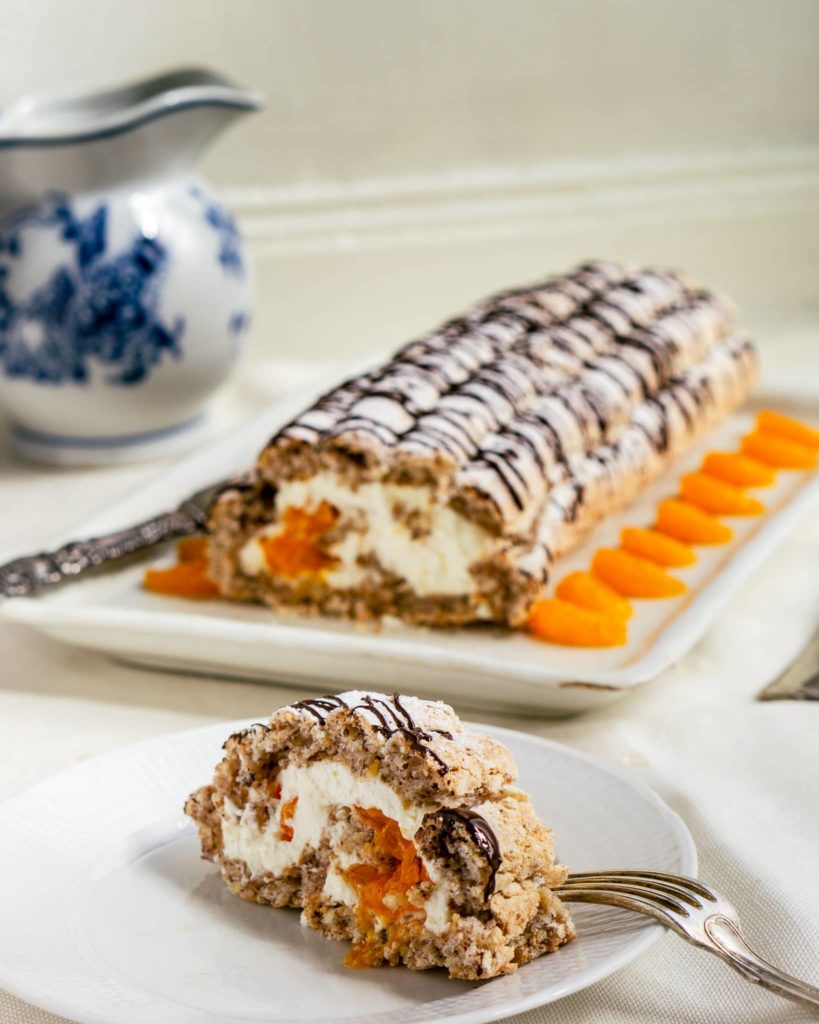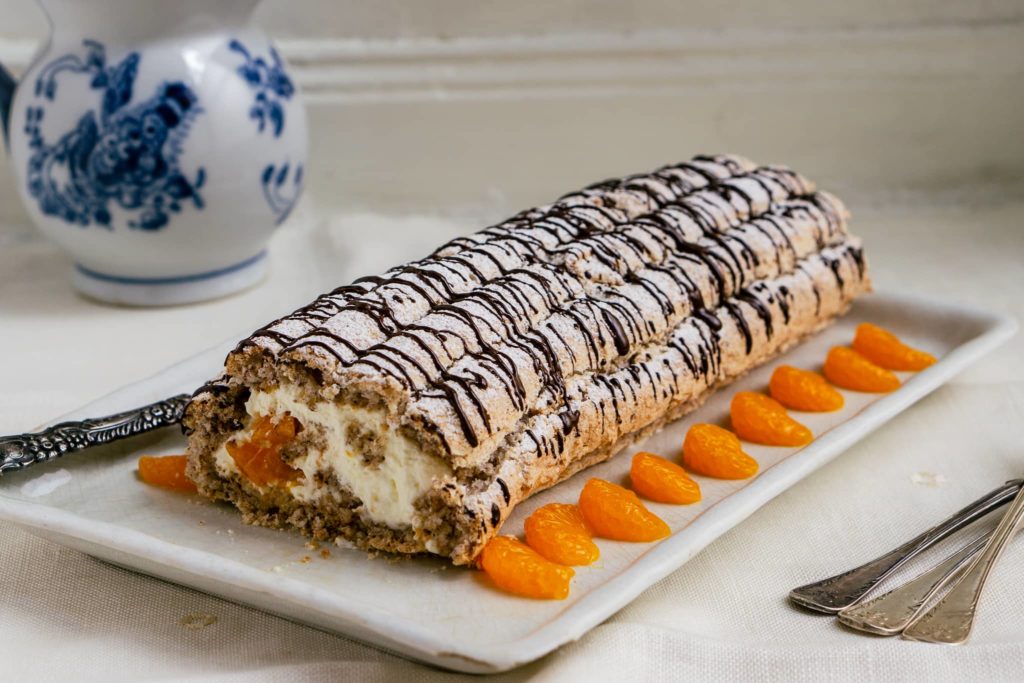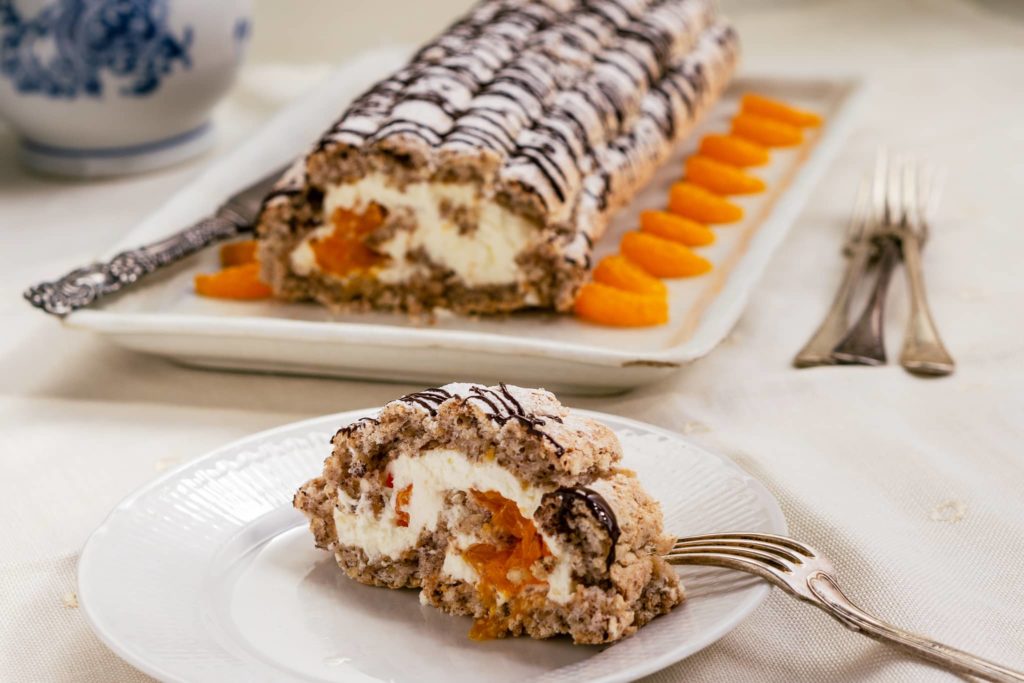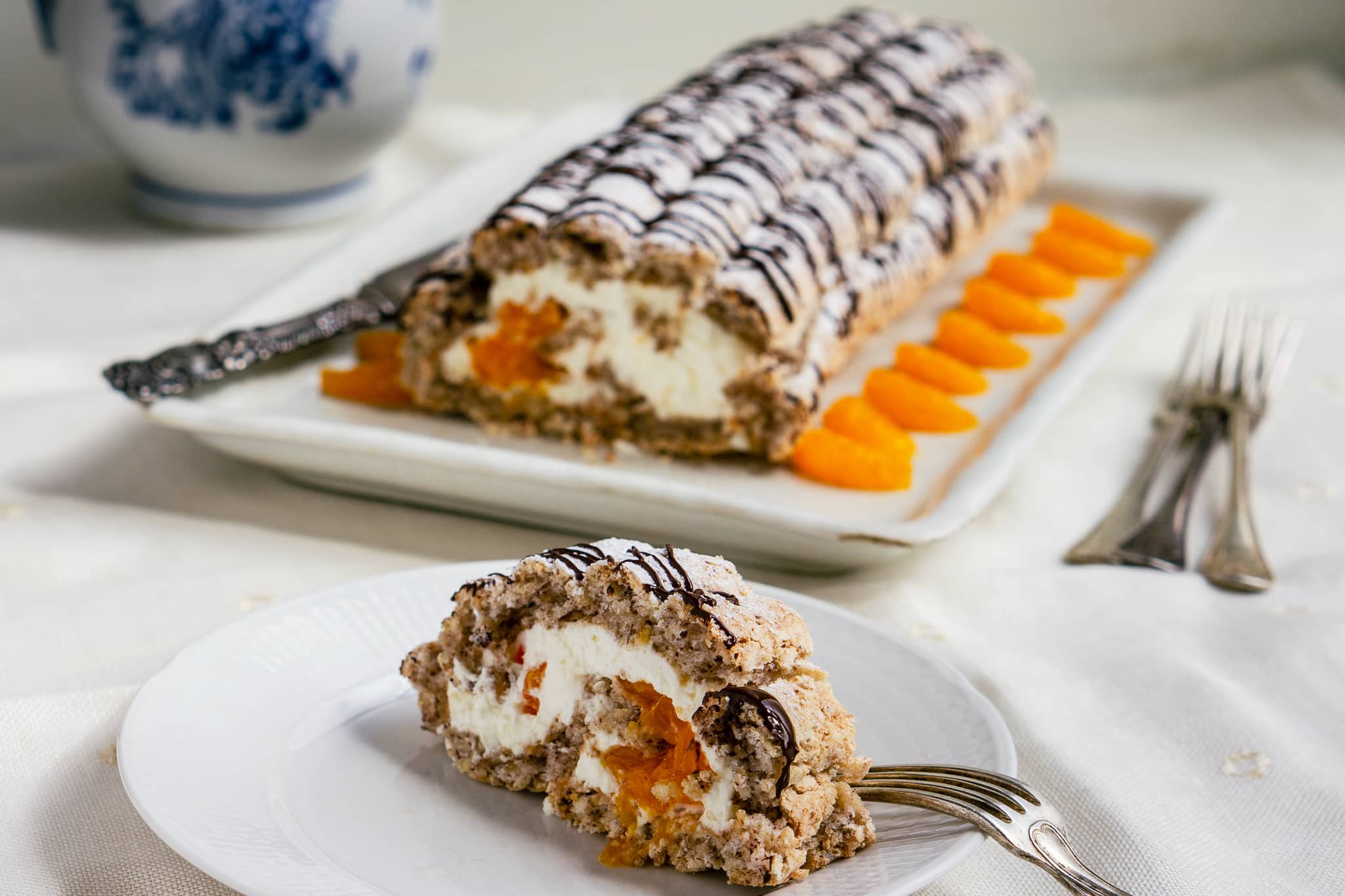The Budapest roll is a classic at Swedish cafés. Here, it is known as Budapestbakelse, Budapestrulle, or Budapestlängd. A traditional version consists of a hazelnut meringue filled with whipped cream and preserved mandarin slices. Nowadays, some bakeries and bakers opt for other fillings instead, such as fresh raspberries or strawberries. The name begs the question — does it have anything to do with Hungary? Let’s find out.

The history of the classic Budapest roll
Let’s take a look at the history of the Budapest roll. In this case, it is the pastry chef Ingvar Strid, born 1926, who is generally considered its creator. Strid was from Vetlanda in Småland. His son, Pontus Antonsson, confirmed that his father created the roll and directed me to a Facebook video (made by Jakob Byskén) where Strid himself shares the details.
The video contains a clip from an interview from 1992, where Strid shares that he invented the Budapest roll ”about 23 years ago”, making 1969 an approximate birth year. The roll was created ”at a modest scale at first”.
So, does it have Hungarian connections?
So, where did Strid get his inspiration for the roll? Does it have an Hungarian origin? Historian Dick Harrison states that the Budapest roll has ”some similarities” to an Hungarian pastry called Esterházy torte. It is however clear that ”the differences also are significant” and it ”must be considered most uncertain” that Strid was inspired by Esterházy. Personally, I can’t see much of a likeness.
In the previously mentioned video, the granddaughter Sara Strid shares that her grandfather travelled a lot as a consultant, both abroad and in Sweden. Strid himself mentions that he worked in America, Spain, and many other places in Europe. (As an aside, the Budapest roll apparently also became a success in Peruvian Lima, thanks to a colleague of Strid.)
As we can see, Strid travelled widely and if the pastry was inspired by another specific pastry, it is difficult to trace. Regarding the origin, Strid mentions that ”we created a small roll with buttercream” which was called Budapest. Then Strid made sure that it was rolled out ”at a bigger scale, with cream”.

Why did the Budapest roll become so popular?
Some 50 years after its supposed birth, the Budapest roll is still one of the classic bakelser (pastries) at the counter of any Swedish konditorier with ambitions. It is especially popular in Vetlanda, thanks to Strid’s origins. When the municipality celebrated reaching 27,000 inhabitants, they did so by serving up a 27 meter long Budapest roll. The Budapest roll even has its own theme day, on the first of May — and a Facebook page, to boot.
So, why did the Budapest roll become so popular? Well, first of all we can recognise that it is tasty. A nut meringue with whipped cream is difficult to beat.
Then, the idea of using preserved fruit is typical for its time. During the 60s, more and more women started working outside of the home. As they normally were in charge of the cooking, it became important to come up with quick desserts. After all, everyday desserts were still a thing… Vår kokbok from 1962 suggests that “fruit — especially citrus fruits and berries as well as preserved fruits and berries are of great importance in the diet”. To open a jar of preserved fruit, such as a ”fruit cocktail” or preserved peaches, was a simple way to get dessert ready in no time. Maybe you had some cream at home, which you poured over the fruit at the table.
So, the preserved fruit increased in popularity during the 60s and 70s. It was considered festive but became more and more common. Even if the fruit counters at the time had an increasing number of exotic additions, they cannot be compared with today’s permanent exhibition of fruits and berries from around the world.
Considering the increased popularity of the preserved fruits, the Budapest roll really is typical for its time.

How to make a classic Budapest roll
The hazelnut flour makes this sweet treat naturally gluten-free. You can spread out the batter however you like — no need for piping — but I recommend that you do it in thin rows so it becomes easier to fold up the roll without it cracking too much. If it cracks, no worries! Just dust some icing sugar or cacao powder on top and it will look mighty festive.
Ingredients
Meringue roll:
150 g (5 1/3 oz) hazelnuts or about 2 1/2 dl (1 cup) hazelnut flour
4 tbsp cornstarch
5 egg whites
2 1/2 dl (1 cup) sugar
Filling:
2 small jars of preserved mandarin slices, or another filling of your choice, such as berries or fruit
3 1/2 dl (1 1/2 cup) whipping cream
Decoration:
1-2 tsp icing sugar or cacao powder (or both, if you so fancy)
25 g (4/5 oz) dark chocolate
Optional: reserved whipped cream and mandarin orange slices
Instructions
- Set the oven to 175°C (345°F). Prepare a baking tray with baking paper. If you want to pipe out the batter, take out a piping bag and a round-holed nozzle, if using.
- Mix in a kitchen mixer or grind the hazelnuts to flour. Stir in the cornstarch.
- Take a large bowl and make sure it is completely clean (no grease). Whisk the egg whites until they form a thick foam — it’s easiest to do with a kitchen or hand mixer. Keep whisking and add the sugar, a little at a time. Make sure that the sugar melts into the egg whites and that the egg white mixture becomes glossy before you add a little more. Towards the end, the meringue mixture will be sturdier and you can be more liberal when adding the sugar.
- Using a spatula, carefully fold the hazelnut mixture into the meringue.
- If using a piping bag, fill it with the batter and pipe out the batter in thin rows, tightly next to each other, going along the long side of the tray. If you’re spreading out the batter, try to spread it out in rows or lines along the long side.
- Bake the meringue on the middle rack of the oven for 18 to 20 minutes. It will have a bit of color and not be wet. Take it out and let it cool.
- Pour the mandarin slices into a sieve or colander and let them drain. Once the meringue has cooled, whisk the cream until it becomes firm.
- Put a sheet of baking paper on top of the meringue. Using another baking tray or cutting board, turn it all upside down so the meringue ends up upside down, with the baked top facing down. Carefully remove the baking paper that the meringue was baked on. Trim the short sides of the meringue with a knife so they become even.
- Save a little of the whipped cream and mandarin orange slices for decoration if you so wish. Spread the whipped cream over the meringue. Scatter the mandarin orange slices all over the cream.
- Carefully roll up the roll from the long side, so you get a long roll. Use the baking paper as a help to make it easier. Place the Budapest roll with the seam facing down.
- Dust icing sugar or cacao powder over the roll. If using, melt the chocolate and drizzle it over the roll. If you wish, decorate the roll with remaining whipped cream and mandarin orange slices.
- Done! Enjoy the classic Budapest roll immediately, or store in the fridge until it is time to serve. It may be even more delicious to enjoy the day after.
Suggestions
The classic Budapest roll is filled with preserved mandarin orange slices. However, you can vary the flavor however you like, depending on what you get hold of and enjoy. For example, you can use other preserved sweet citrus fruits, fresh or thawed berries such as raspberries or blueberries, or any other soft fruit of your liking. You can also use almond flour instead of hazelnut flour for the meringue.
I’ve seen some recipes adding a tablespoon of cacao powder to the batter. Personally, I prefer it without, but feel free to test it and see what you like the best.



Jättebra recept. A great and rather easy Budapest roll to make
Thanks much
Tack så mycket, Ulla!
Just came back to Washington, DC visiting daughter and newborn in Stockholm and being Hungarian-American, bought home for her a Budapest pastry since she is also gluten free. She commented that’s one of her favorite pastries. So, looked it up and now know the provenance and the recipe! Tack! Köszönöm!
Oh, what a lovely coincidence! Yes, it is the perfect treat if you want something gluten-free. Hope you enjoyed it, too.